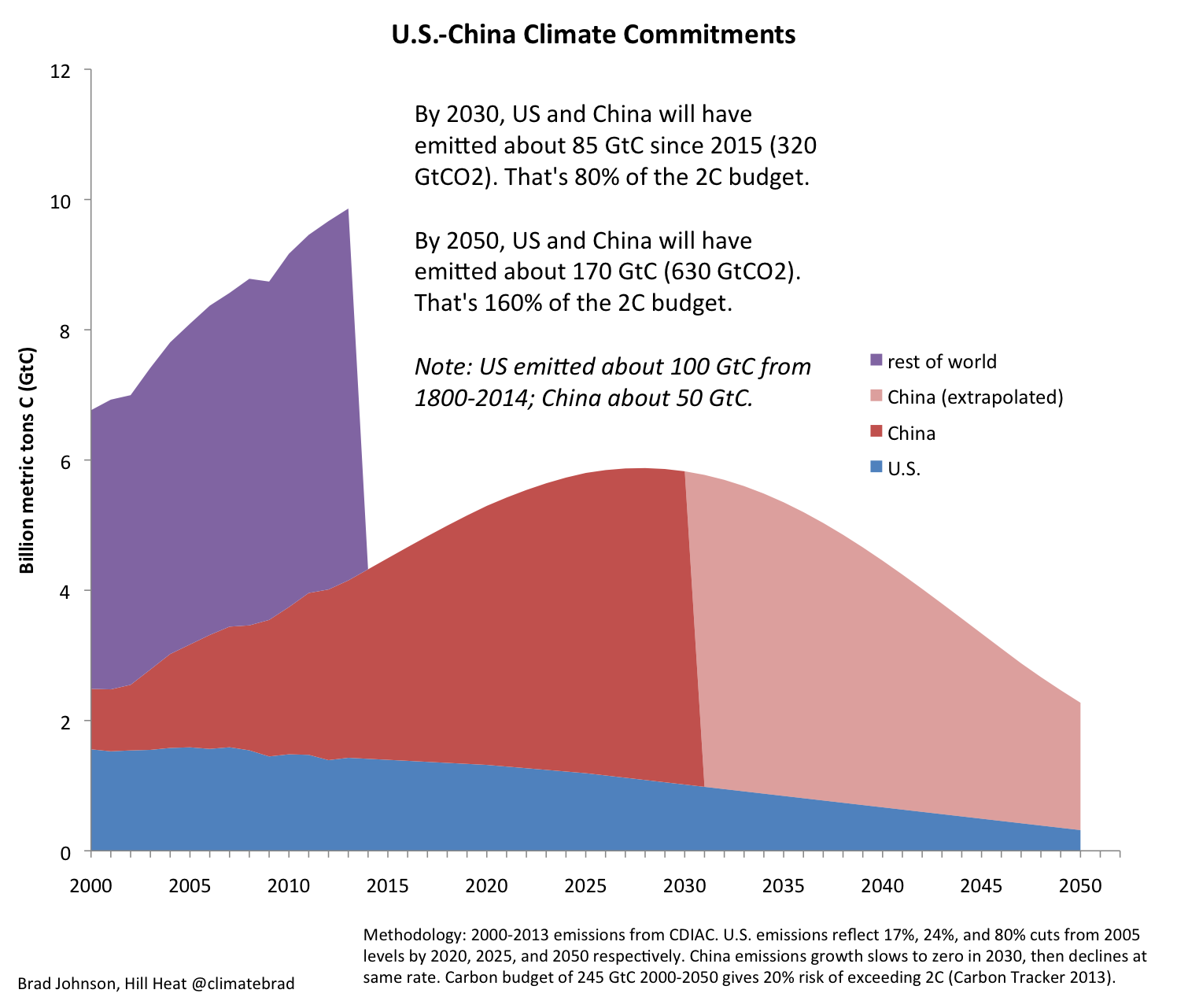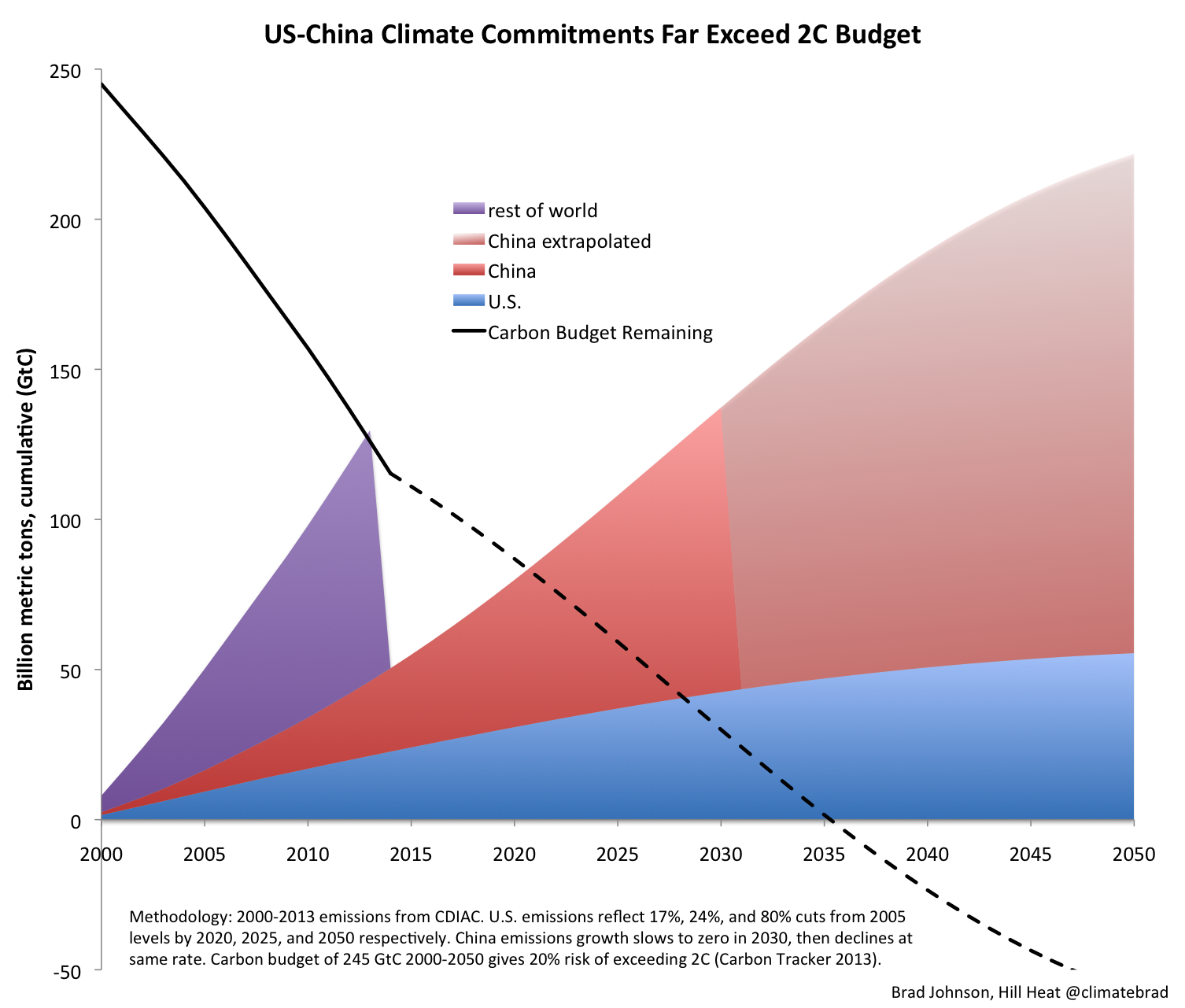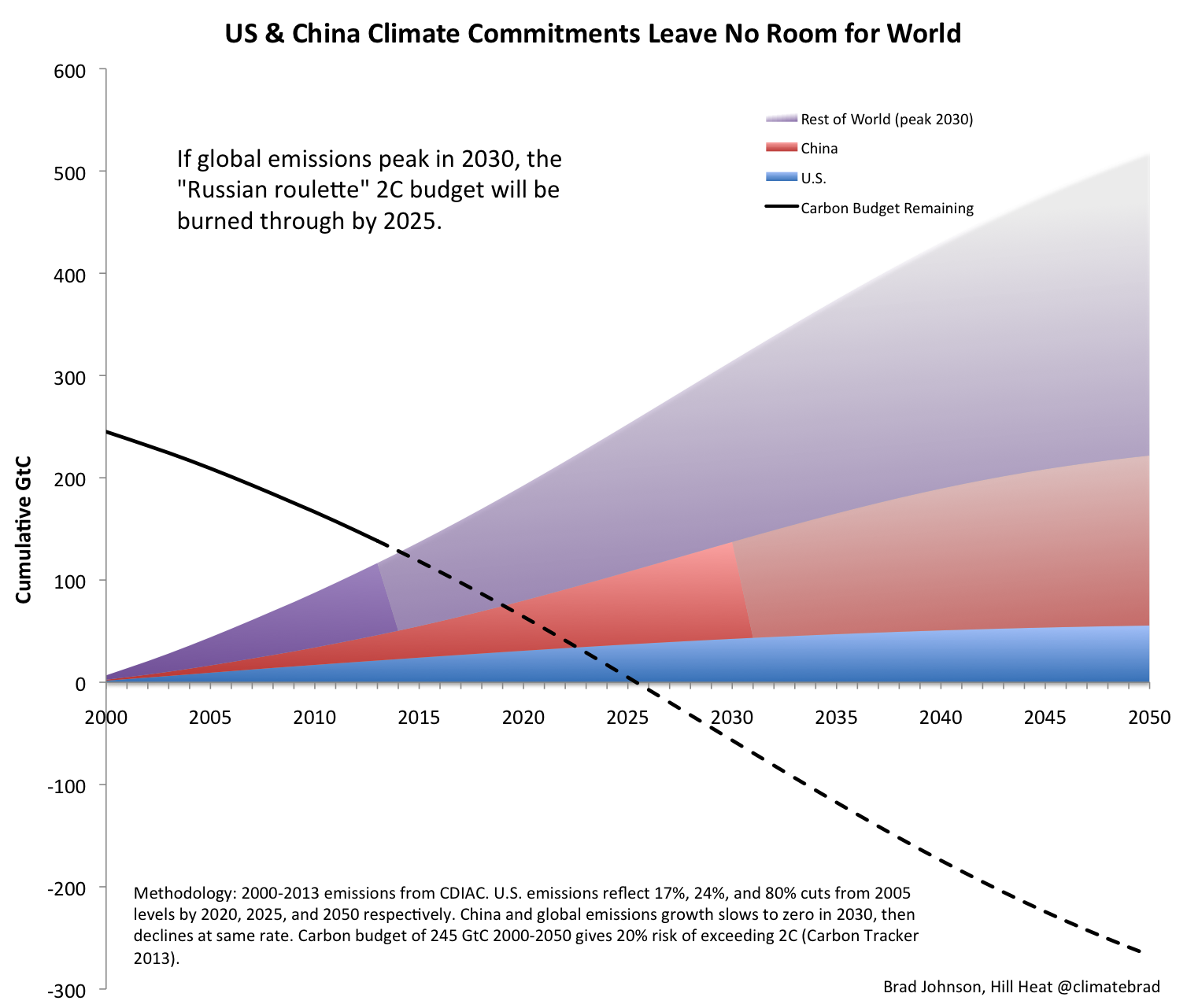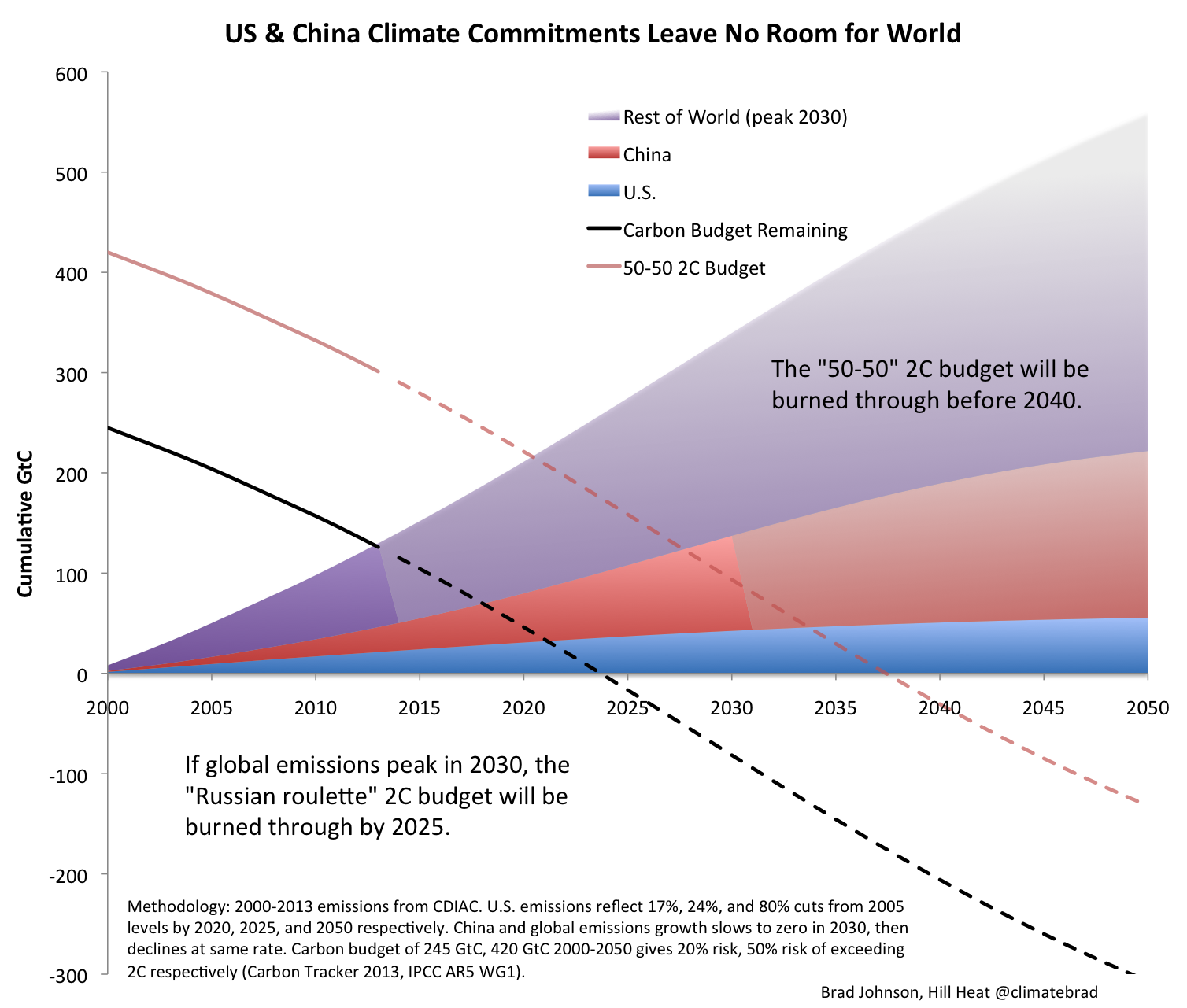Graphs: U.S. and China Climate Commitments Leave No Room For World
The climate commitments announced by Presidents Barack Obama and Xi Jinping in China are momentous given the political status quo, but they still leave human civilization on a catastrophic trajectory, a Hill Heat analysis shows.
The non-binding targets agreed to in Beijing — that China would peak in emissions by 2030 and the U.S. would accelerate emissions cuts to reach 80 percent of current pollution levels (74 percent of 2005 levels) by 2025 — are a positive step forward. Without such targets catastrophic warming is guaranteed.
President Obama reaffirmed that limiting global warming to less than 2°C (3.6°F) above pre-industrial levels is his goal, claiming the announced targets “means the United States is doing its part to contain warming to 2 degrees Celsius.”
What do the announcements actually mean in the context of what is needed?
Below, we explore the targets in the context of a “Russian roulette” 2C pathway, with pollution levels that scientists estimate lead to a one-in-five chance of exceeding 2C. (Ed.: Russian roulette odds are actually a bit better.)

By 2030, US and China alone will have emitted about 80% of the carbon budget, leaving the other 75% of the global population with little to spare. By 2050, US and China will have emitted about 160% of the carbon budget, making the “Russian roulette” scenario impossible. To be clear, even 2C warming is highly risky, to say the least (Hansen et al, 2013).

Graphing cumulative emissions, the U.S.-China trajectory becomes more readliy apparent, as the combined carbon footprint continues to grow rapidly through 2050. The carbon budget is used up by the two nations’ pollution alone by 2035.
The Trillionth Tonne Problem
How did we get to this point? About 420 gigatons of carbon were burned (1540 GtCO2) from the beginning of the Industrial Revolution to 2014, one quarter of which came from the United States, one eighth from China. Most of China’s carbon pollution has been emitted in the past 15 years. The 2015-2050 budget for an 80% chance of staying below 2C warming is only 105 GtC (390 GtCO2) more. Right now, human civilization is emitting about 10 GtC (39 GtCO2) a year—which means that even if global emissions growth slows, the carbon budget will be exceeded within about ten years.
This conundrum has been referred to as the “trillionth tonne” problem, which (somewhat confusingly) has been formulated in two different ways. One is that the 2000-2050 budget for a 75% chance of staying below 2C warming was estimated in Meinshausen et al. 2009 at 272 GtC, which equals 1000 GtCO2—that is, one trillion metric tons of carbon dioxide. (Ed.: The use of the British spelling “tonne” is a useful indicator of the 1000-kilogran metric “tonnes” used in the U.K., as opposed to the 2000-pound short tons used in the U.S., which are a bit smaller. Each metric ton of carbon is the equivalent of 3.67 metric tons of carbon dioxide due to the added oxygen atoms.)
Alternatively, the all-time budget (starting with the Industrial Revolution and going forward to 2500) for 2C being the mostly likely warming scenario, with a 95% interval of 1.3-3.9C warming, was estimated in Allen et al. 2009 at 1000 GtC — or one trillion metric tons of carbon. With about 560 GtC burned 1751-2014, that leaves 440 GtC for the rest of time for humanity to burn for less than even odds of staying below 2C.
These competing formulations of the “trillionth tonne” problem were co-published in the April 30th 2009 issue of Nature.
Both mechanisms of analysis — which are confirmed, updated, and bolstered in the IPCC’s Fifth Assessment Report (Working Group 1 Chapter 12) — are based on the warming impact of all climate pollution, which is predominated by carbon dioxide from burning fossil fuels and deforestation, but also includes methane, aerosols, nitrous oxides, and exotic super-greenhouse gases. Aerosols, which reduce warming by blocking out the sun, are on the decrease, while non-CO2 greenhouse gases are increasing. The calculations in this post are based on the assumption that the CO2 emissions calculated by the Carbon Dioxide Information Analysis Center can be used in lieu of the total CO2-equivalent emissions. That assumption is increasingly untenable, especially as nations switch from coal to natural gas, which increases methane emissions. Thus, the scenarios presented here-in should be considered optimistic.
The construction of any new fossil-fuel infrastructure, such as the Keystone XL pipeline, is simply incompatible with a pathway toward climate safety. This fact is implicitly acknowledged in the climate-impact analysis of the tar-sands project, which uses a high-emissions energy scenario as its baseline.
In summary: anyone who believes “we have a moral obligation to fight climate change,” to use President Obama’s words, should be working to phase out all of our existing fossil-fuel infrastructure over the coming ten years, with the goal of a carbon-negative global economy.
Even if the rest of the world follows the US and China lead with commitments to stop emissions growth by 2030, there will be a high risk of catastrophic global warming. Assuming the US and China meet their targets and the rest of the world follows suit, humanity will burn through the Russian-roulette chance at staying below 2C warming before 2025.

For small-island nations, coral reefs, global forests, Arctic ice, permafrost, and global ice sheets — and quite possibly the rest of human civilization — to have a long-term chance of survival, limiting warming to 1.5C looks to be needed. (This would require a rapid transition to a fossil-free economy with massive reforestation to reduce existing CO2 concentrations in the atmosphere to 350 parts per million or lower, the inspiration for the name of the climate organization 350.org.)
A higher tolerance for catastrophic warming — by raising the risk of 2C warming from 20 percent to 50 percent — gives the world a more leeway for pollution, but not enough to make the announced US-China targets “safe”. The global budget for a 50-50 chance of 2C warming will be exhausted before 2040.

The insufficiency of these newly announced targets — and the howls of outrage heard from the Republican Party in the United States — reflect the dangerous power the global fossil-fuel industry has over our future, at a time when our species’ collective power should be directed at building a fossil-free civilization.